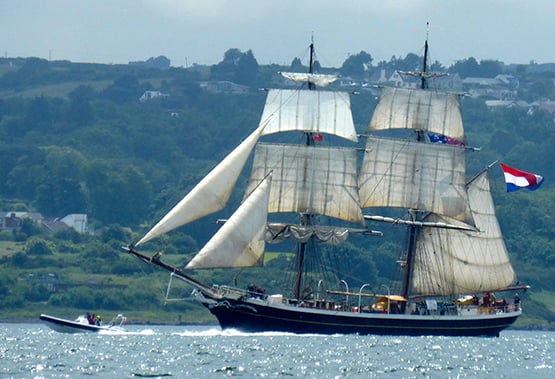Displaying items by tag: Oliver Hart
High Hopes for Ireland's Tall Ship – The Force is With Them
The governments in both jurisdictions in Ireland have included an all-Ireland sail training ship for the Atlantic Youth Trust in their long term capital expenditure proposals. And the movement in favour of support for this project has become so strong that the nationwide team involved in promoting it are confident that the ship’s future is now secured.
They continue to hold this view even with general elections and possible major changes in administrative direction taking place, north and south, within the next four months. Thus this week’s 2016 Annual General Meeting of the Atlantic Youth Trust in Irish Lights Headquarters in Dun Laoghaire found itself reviewing a remarkable year of progress and achievement, while giving pointers and reassurances for the successful way ahead. W M Nixon was there to take on board an evening of multiple messages.
It could well be that some time in the future, we will come to the sad but inescapable conclusion that the foundering of the Republic of Ireland’s national 84–ft sail training brigantine Asgard II in September 1908, followed within two years by the sinking of the Northern Ireland 70ft training ketch Lord Rank, were necessary disasters for the progress towards the ultimately more healthy ideal of a Class A 40-metre sail training barquentine.
The proposed ship - determinedly and enthusiastically serving all Ireland – will be initially funded through donations, and by government grants from both sides of the border. But the vessel is to be run independently by a cross-border trust rather than by some obscure unit of a government department.
September 2008 saw Ireland on the edge of the financial abyss. For a government under enormous pressure from all sides, a government, moreover, in which the minister responsible for the Asgard II took little or no interest in the ship and what she did, this sinking was a blessing in disguise.
The hull of Asgard II, completed in 1981, had long passed its sell-by date. When she sank, she took with her the magnificent rig which had been totally replaced only a couple of years earlier. Yet a properly involved government would surely have taken on board the advice that her timber hull urgently needed replacing, preferably with one built in steel. For although in 2008 the ship looked better than ever thanks to the devotion of her crew in working way over and above the call of duty in painting, varnishing and routine maintenance, there was no escaping the fact that the basic hull and its original fittings were living on borrowed time.
Ironically, the visit to La Rochelle, which she was nearing when she sank, included plans for a three-week stopover for a complete survey and some necessary repairs. Whether or not this would have revealed the fracturing seacock which many reckon to have caused the unstoppable ingress of water can only be a matter of speculation. The fact of the matter is the ship sank, and in an exemplary display of seamanship, the captain and crew ensured that their full quota of young trainees got safely away.
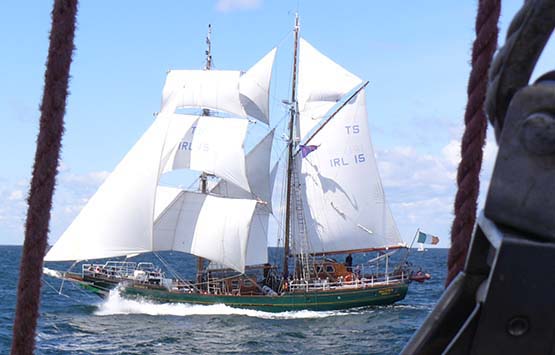
Flying the flag for Ireland – Asgard II in fine form, seen from another tall ship
But although Asgard II remained stubbornly intact and upright for some weeks on the Bay of Biscay seabed off Belle Ile, a government with financial Armageddon crashing down around its ears was glad enough to be shot of a unique project which some of them had never really understood or supported in the first place. Thus they refused to consider multiple suggests as to how best Asgard II could be salvaged. And frankly, it was for the best that they did so. For like it or not, while she was much-loved by the maritime community, the vessel had lost public confidence.
The subsequent loss of the Lord Rank in July 2010 after striking a rock likewise resulted in a merciful absence of casualties. But with Ireland north and south now in the utter depths of economic recession with no governmental enthusiasm whatsoever for non-essential projects, it was time to re-group for a few years and re-think the entire sail training ideal. It became almost an underground movement, with Coiste an Asgard being re-structured as Sail Training Ireland, and diligently setting about placing Irish trainees on the ships of other nations. It’s an ongoing programme which has been notably successful in providing both sea-going experience and a guaranteed international dimension for young people from all over Ireland, city and country alike.
Meanwhile there were rumblings from the west of Ireland where Enda O'Coineen and John Killeen were building on the can-do attitude of Galway, and from this there gradually emerged the Atlantic Youth Trust. It’s a determinedly all-Ireland group in which the Chairman is former Winter Olympics Gold Medallist Lord Glentoran from Northern Ireland, with the unstoppable unsinkable O Coineen as President. Supporting them is one very impressive list of seriously heavy hitters in the maritime and big business sphere from all over Ireland on its board, and perhaps most importantly of all, at an early stage they secured Neil O’Hagan as Executive Director.
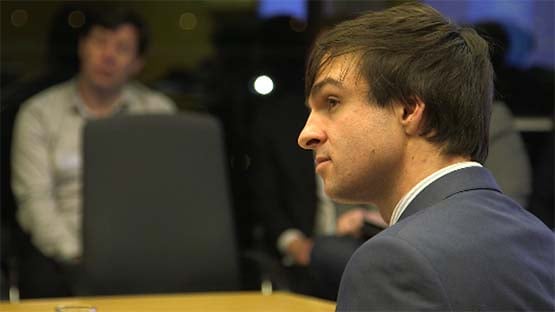
Neil O’Hagan, Executive Director of the Atlantic Youth Trust
This sounds an impressive title, but at the moment he heads up a minimal staff. You can get the flavour of it all by taking a look at the Sailing on Saturdays conversation I had with him, reported here on 4th April 2015. The amount of work he puts in is prodigious, and though the Trust’s founding General Meeting was held in Belfast in the Harbour Commission’s historic building on September 10th 2014, they’d to forego a General Meeting during 2015 while various elements and agreements were being finally edged into place.
Since April 2015 we’ve had snippets of news about the governments north and south starting to provide what are essentially government letters of intent in support of the project. However, politics on this island being a snakelike progression notwithstanding the best efforts of St Patrick, with every twist and turn of the political machines the AYT have been at pains to ensure that gains supposedly agreed by one administrative decision-maker are carried through into the remit of the next when the inevitable political wheel of fortune turns yet again at the individual level.
But now, with two general elections in the offing and a rapidly improving situation developing in the AYT’s prospects, it was essential for a properly-convened AGM to be held on Thursday January 21st, staged this time in the impressive board-room of the Irish Lights Commissioners in Dun Laoghaire.
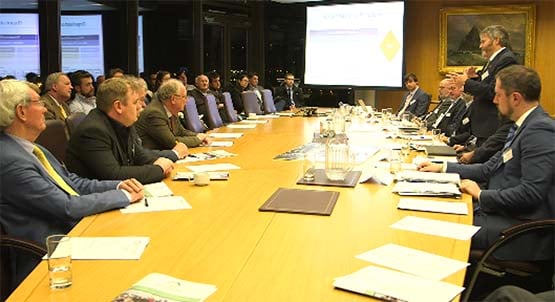
The boardroom at Irish Lights HQ is an impressive venue for any meeting, and it suited the Atlantic Youth Trust’s 2016 AGM very well
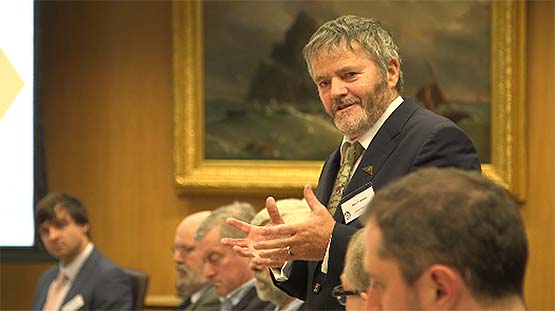 The maritime evangelist……Enda O'Coineen in full flight at this weeks AGM of the Atlantc Youth Trust
The maritime evangelist……Enda O'Coineen in full flight at this weeks AGM of the Atlantc Youth Trust
Ironically, although one of the main lines of thought in the AYT’s thinking is that the ship they’ll provide will be more of a floating multi-discipline schoolship of many projects, both afloat and ashore, rather than a traditional sail training ship, it emerged at the AGM that it was the traditional Tall Ships visit and Parade of Sail in Belfast and on Belfast Lough last July which gave them their greatest boost.
They’d a significant presence there, and thanks to one of the Trust Board Members, they’d the use of a fine big motor vessel aboard which visiting politicos and other heavy hitters could be taken on a sociable yet instructive tour of the harbour and the Tall Ships fleet. For many of these decision makers and opinion formers, it was a transformative experience, turning them into supporters of the Atlantic Youth Trust’s way of thinking.
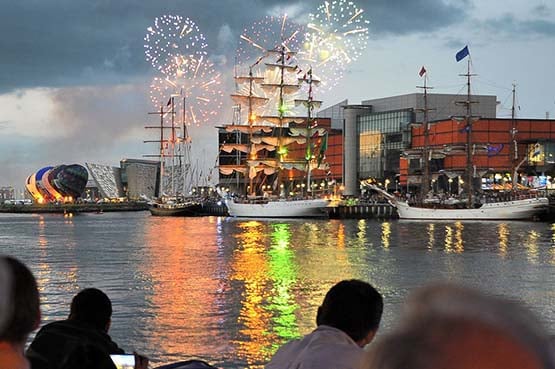
The Tall Ships in Belfast, July 2015
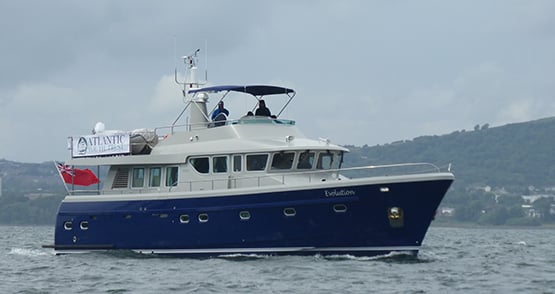
This opened doors north and south, and they rapidly increased their already formidable knowledge of how to work the corridors of power. The meeting on Thursday in Irish Lights was chaired by Peter Cooke from the north, and his affable presence made the running of business very smooth indeed. But as each specialist on the board revealed the progress they’d made during the past year and more in their particular task, it was to realize that here were people who were utterly professional in their approach, yet went at the job with the total enthusiasm of dedicated amateurs.
But what most impressed was the synergy of the high octane talents on the board which, in addition to Lord Glentoran, Enda O Coineen and Peter Cooke, can draw on the talents of people of the calibre of Dr Gerard O’Hare, Roger Courtney, Sean Lemass, David Beattie and John Killeen – with Neil O’Hagan as the key conduit, they’ve turned themselves into a formidable lobbying organisation.
It’s a fact of life in all Irish political administration, and particularly in Dublin, that each separate government department much prefers to function independently within its own little bubble, with nothing whatever to do with any other department while avoiding overlaps if at all possible. This is especially so in the neglected area of maritime activity, which is overseen by several departments, and is further warped by the reality that the government is in Dublin - which is also the biggest port - yet the real scene of the maritime action and the true hotbed of ideas is Cork.
So our shrewd operators in the AYT stood back and concluded that the politician they should most directly target was of course Minister for the Marine (and many other matters) Simon Coveney TD of Cork, but that in Dublin the departments to be wooed were Finance and the Office of the Taoiseach.
With increasing support at official level in the north and enthusiasm from key decision makers in the Republic, things were going grand when the President of the AYT suddenly went off in December 2015 to race single-handed across the Atlantic from the Caribbean to Brittany in his IMOCA 60 Kilcullen Voyager. Enda O’Coineen’s big boat has been very much part of the AYT awareness programme for the past year, taking trainee crews to sea. But this was something else altogether, and it made many supporters of the new training ship ideal distinctly nervous.
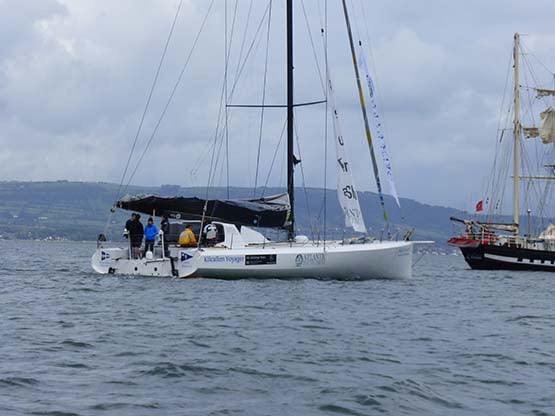
Racing across the Atlantic in as rough a December as anyone could remember may have been a personal challenge, but inevitably it was a high risk venture with which the AYT was inevitably associated, whether it liked it or not. The sailing community in Ireland is small, and nothing can happen in isolation. But to everyone’s enormous relief, not only did the boy do it, but he did it well, sailing across in style and securing a podium place with third at the finish.
This was quietly acknowledged as something which had been on everyone’s mind in a graceful little speech by the Deputy Chairman of the Irish Lights Commissioners congratulating the President on his Transatlantic success. So with everything in place as regards where AYT now stands in relation to both governments, the formal part of the meeting concluded with some commitments as to the way ahead, and the news that the Atlantic Youth Trust’s next public gathering of significance will be in Galway on March 12th, when more precise details of the new ship and the building programme will be revealed.
However, with an ethos in which going the extra mile is part of the DNA, the AYT then laid on a hugely entertaining dinner in the neighbouring Royal Irish YC with fascinating shows by the Gardai Siochana’s Conor O’Byrne, who played a central on-board co-ordination role in rescuing a crewman who had gone overboard in mid-Pacific from the Clipper yacht Derry-Londonderry-Doire, and from Stewart Hosford from Cork, who is CEO of the organisation Five Degrees West whose main project is the designing, building and management of the Imoca 60 boats raced under the Hugo Boss campaign by Alex Thompson.
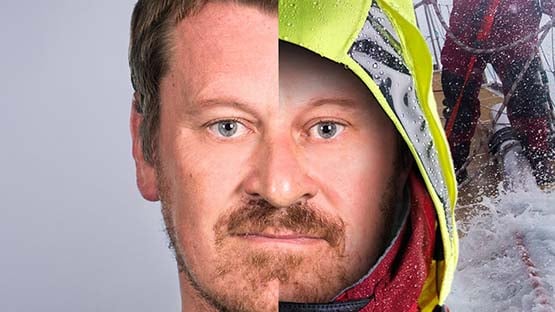 May The Force Be With You – the two faces of the Garda Siochana’s Conor O’Byrne, who gave the AYT and its supporters a fascinating insight into the successful rescue of a crewmember who went overboard from Derry/Londonderry/Doire in mid-Pacific.
May The Force Be With You – the two faces of the Garda Siochana’s Conor O’Byrne, who gave the AYT and its supporters a fascinating insight into the successful rescue of a crewmember who went overboard from Derry/Londonderry/Doire in mid-Pacific.
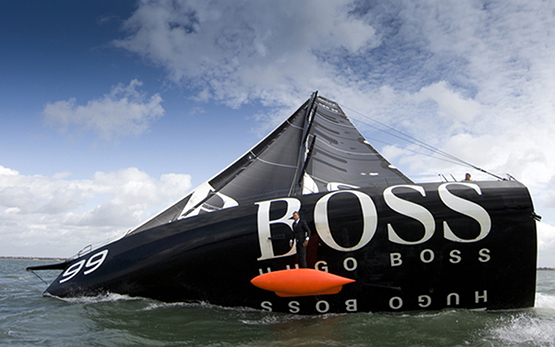 Suits you, Sir…..Alex Thompson on the second Hugo Boss. At Thursday’s meeting, Stewart Hosford of Cork – whose interest in the sea and sailing was inspired by Asgard II – gave the inside story on his job as CEO of the Hugo Boss sailing challenges.
Suits you, Sir…..Alex Thompson on the second Hugo Boss. At Thursday’s meeting, Stewart Hosford of Cork – whose interest in the sea and sailing was inspired by Asgard II – gave the inside story on his job as CEO of the Hugo Boss sailing challenges.
Each compact yet thought-provoking show would have made for a worthy topic on its own in most clubs’ entertainment programme. But it was special to include both on this night of all nights, as each speaker had been enthused in their youth by sailing on Asgard II, and each would do anything to ensure that the upcoming generations get a similar opportunity and inspiration.
It was that kind of night, with the congenial attendance including Seamus McLoughlin and Michael Byrne from Sail Training Ireland, and Oliver Hart whose 70ft schooner Spirit of Oysterhaven continues gallantly to fulfill the role of Ireland’s premier sail training vessel from her base on the Cork coast.
In all, it’s a busy few days for Irish sail training, which is definitely no longer an underground movement. Today, Sail Training Ireland hold their 4th Annual Prize Giving and Programme Launch in the Mansion House in Dublin, looking back on a season in which the number of funded trainees sent on sailing ships abroad and at home came in at just under 300, while in all they arranged berths for more than 500.
The plan for 2016 includes a formal twinning of Dublin and Liverpool for maritime festivals, while on the training front, STI are aiming for a target of 350 funded trainees. And as for Ireland eventually returning to having her own sail training ship, no sooner was Thursday night’s remarkable series of events brought to a close than Neil O’Hagan had to gather his thoughts and head off for New York to meet the Ireland Fund. They are taking a serious and very positive interest in the plans of the Atlantic Youth Trust.
